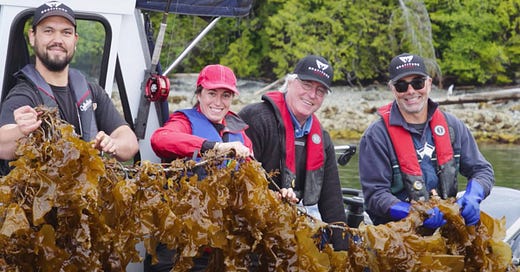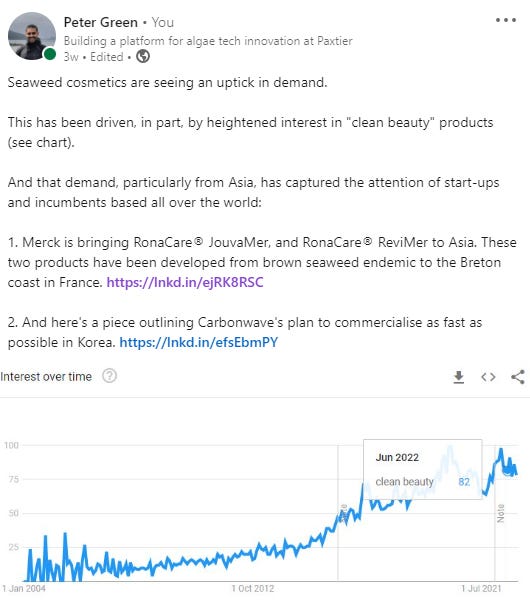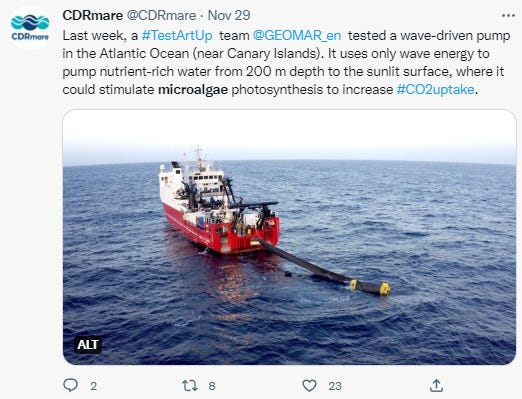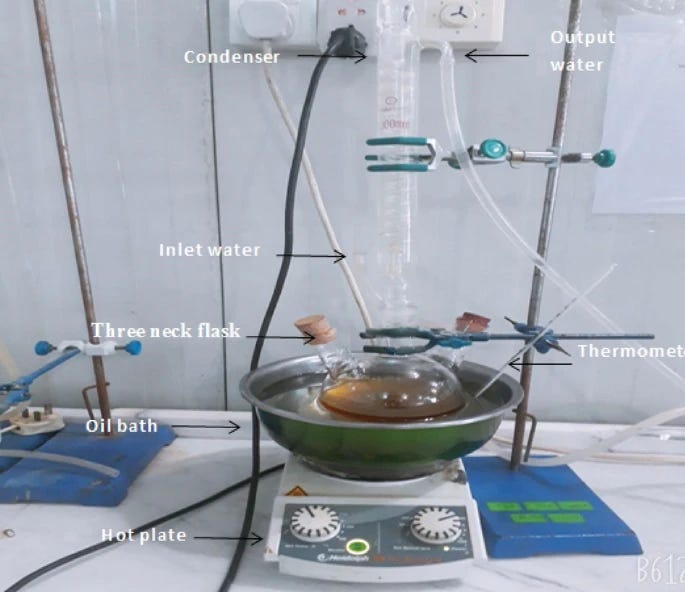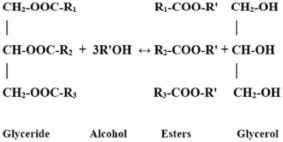🌍Who's using AI to monitor biodiversity on kelp farms?
PLUS: L’Oréal is acquiring a stake in Microphyt, and a look at algae biodiesel
"Our engineers have now developed ‘kelp cams’ – underwater cameras which use artificial intelligence to identify fish species and monitor biodiversity." — Robert Napoli, CFO of Cascadia Seaweed
Dear algae technologists - hello and welcome to the Paxtier Report!
In breaking news this week, L’Oréal’s venture capital fund, BOLD, is acquiring a minority stake in Microphyt to support the consumer product giant's ambitions in green biotech.
The move will help support L’Oréal’s 2030 sustainable development goals, which include leveraging 95% biosourced ingredients and going after the clean beauty market. But they’re not the only ones targeting clean beauty using algae:
(Read more HERE).
In today’s report:
Markets: 💸 Scotland’s Oceanium has launched the seaweed-derived Ocean Health Fibre, a one-to-one replacement for synthetic methylcellulose
Deals: 🤝 L’Oréal’s venture capital fund, BOLD, is acquiring a minority stake in Microphyt
Movers and Shakers: 🌍 AI, Biodiversity and First Nation Partnerships with Cascadia Seaweed
Around the web: 💊 Kiwi scientists have developed the world's first microalgae-based pain medication...
Research Rundown: 📝 Investigating spirulina biodiesel performance
Markets and Investing
✂️Algae Market Snippets
Some big moves in recent weeks:
BettaF!sh will be on the Menu della Casa at 157 L'Osteria restaurants in 8 countries from December 6th. (Read more HERE). And Japan Airlines is now offering BettaF!sh Plant-Based Tuna on select flights.
Scotland’s Oceanium has launched the seaweed-derived Ocean Health Fibre, a one-to-one replacement for synthetic methylcellulose, a common food ingredient in the plant-based segment. (Read more HERE).
The World’s first hybrid meat innovation centre to open in Singapore in 2023 (Read more HERE).
Notpla – one of the 15 finalists in Prince William’s Earthshot Prize 2022 – is launching a new range of 7 packaging solutions coated with seaweed to accelerate true sustainable offers within the takeaway industry. (Read more HERE).
Fishing businesses and marine organisations in Scotland’s coastal communities will benefit from Marine Fund Scotland’s latest round of funding. 60 projects will receive grants ranging from £7,000 to £1.2 million. (Read more HERE).
Hatch's latest Innovation Studio cohort set to make waves at World Aquaculture Singapore 2022 (Read more HERE).
CSIRO is partnering with Google Australia to deliver a new Indo-Pacific coastal ecosystem mapping initiative. (Read more HERE).
Kiwi scientists have developed the world's first microalgae-based pain medication...💊The team have found a reliable and commercially scalable method for producing the shellfish toxin neosaxitoxin from Alexandrium pacificum..."And when this compound is combined with existing local anaesthetics, it produces more effective, longer-lasting pain relief that is not addictive."(Read more HERE).
In case you missed it - scientists are now spreading baby kelp across 7,000 square metres off the Tasmanian coast. 🌊(Read more HERE).
Oceanfarmr has raised $1.45 million for its 'Google Maps of the ocean' platform! The company now keep tabs on the analytics and mapping of over 70 aquafarms worldwide. And revenue has surged 874% in the past twelve months.(Read more HERE).
More than 15,000 Indonesian seaweed farmers devastated by the Montara oil spill in 2009 will receive US$129 million from PTTEPAA as an out-of-court settlement. (Read more HERE).
Japanese steel firm plans national roll-out of blue carbon projects after first issuance. (Read more HERE).
Aqua-Spark secures further €15m from Asian investor group (Read more HERE).
L’Oréal’s venture capital fund, BOLD, is acquiring a minority stake in Microphyt to support the consumer product giant's ambitions in green biotech, particularly from algae-derived materials. (Read more HERE).
Sarawak’s microalgae production facility is expected to be launched by February next year. (Read more HERE).
A collaboration between design studio Post Carbon Lab, and French car company DS Automobiles unveiled a collection of garments that suck carbon from the atmosphere. The four unisex items are covered in live algae. (HERE)
In depth with Peter Green
🌍AI, Biodiversity and First Nation Partnerships with Cascadia Seaweed
Robert Napoli is the CFO of Cascadia Seaweed, a macroalgae cultivation company based in British Columbia.
As the largest kelp cultivator in Canada, Cascadia currently operates 7 ocean farms across 26 hectares of ocean.
And in this snippet from our recent call, Rob and I discuss the evolution of the organisation, ecosystem services, and the team’s fundraising efforts.
How has Cascadia Seaweed evolved to where it is now?
It all started in 2019, when our founders began working with Coastal First Nations. Over the years, these communities have suffered immensely from natural resource depletion. And seaweed cultivation was seen as a potential solution.
Soon after these initial discussions, we put some farms in the water. And now, 3 years later, we operate 100 kilometres of production line across 7 farms – growing sugar kelp and giant kelp.
When it comes to markets, we’re primarily developing feed additives and biostimulants for agriculture. These categories have been around for decades, but pressure to reduce greenhouse gas emissions and fertiliser-use in industry is driving increasing demand.
What’s more, livestock farmers have seen how seaweed can improve feed conversion and growth rates. This means they can reduce the feed input per unit output. And that’s a compelling driver – not to mention the fact that our products have shown some methane reduction capabilities too.
How much is Cascadia fundraising?
We’re raising $15 million Canadian dollars to help us with expansion, bioprocessing and product development. This capital will be deployed over the next 2.5 years and will help us get to 5x capacity – circa 4000 MT fresh weight per annum. And to hit that target, we’ll need about 100 hectares of ocean, which our First Nation partners are eager to provide.
Eventually, we would like to farm 50,000 hectares in British Columbia, which will make us a major player in North America and help us significantly reduce greenhouse gas emissions in agriculture.
What have Cascadia been doing on the ecosystem services front?
After a short while, we noticed the positive impact our farms were having on the environment. For example, local loggers mentioned the abundance of wild seaweed and fish around our farms. They even saw bears moving back into the area. And this encouraged us to launch an ecosystem services side of the business.
In this regard, we’ve since embarked on some research to develop Green Gravel – a technology that can be used to reforest kelp beds. And our engineers have now developed ‘kelp cams’ – underwater cameras which use artificial intelligence to identify fish species and monitor biodiversity.
What advice would you give to someone else starting on this journey?
Raise more money than you thought you needed. Inflation has really increased costs this year. So, I’d recommend that you are conservative on that front!
If you’d like to learn more about Cascadia Seaweed or join them in their mission, check out the company. You can also follow Rob on LinkedIn here.
🐦Tweet of the week
📝Research Rundown: Investigating spirulina biodiesel performance
THE BIG IDEA
Recently, Al-Dawody et al. showcased how to create and test algae biodiesel.
The breakdown
The first step involved transforming spirulina algae oil into spirulina algae methyl ester (SAME), a type of biodiesel, through the process of transesterification in a 1-l three-necked flask (see below).
Three volumetric blends of SAME were then added to standard Iraqi diesel (10% SAME, 20% SAME, and 30% SAME) and run through a single-cylinder engine under variable load and compression ratios.
As expected, the team noted that SAME blends caused higher Brake specific fuel consumption (BSFC), carbon dioxide emissions (CO2), and nitrogen oxide levels (NOx) compared to standard diesel fuel - due to the additional oxygen content in biodiesel.
To deal with this, Al-Dawody et al. increased the engine’s compression ratio, which noticeably decreased carbon emissions. But this only caused cylinder pressure and temperature to rise, leading to a surge in NOx emissions.
So, when reading, be sure to check out…
The team’s optimal blending compromise (30% SAME) and the suggestions for tackling NOx emissions using nanoparticles.
🔥 What else was hot in algae tech?
WATCH: Next-gen biomanufacturing… from lower-cost feedstocks for precision fermentation to ‘cell-free’ approaches (Read more HERE).
(Paper) Potential use of engineered nanoparticles in ocean fertilization for large-scale atmospheric carbon dioxide removal. (Read more HERE).
An ambitious plan to sequence the genomes of all known species of euglenoid algae over the next decade has been launched this week. (Read more HERE).
New technology maps movement of microscopic algae, crucial to ocean health (Read more HERE).
Czech scientists explore possibility of plastic-eating cyanobacteria tackling ocean waste (Read more HERE).
Salmon scent from plants & EU strategy to boost algae production (HERE).
Australia and China team up for project to replace plastics with seaweeds (Read more HERE).
Scientists have found red seaweed 100 metres deep in Antarctica (Read more HERE).
Scientists aims to recycle marine life growing on oil rigs (Read more HERE).
(Paper) Cyanophages as an important factor in the early evolution of oxygenic photosynthesis (Read more HERE).
Microalgae: A sustainable food source for fish (Read more HERE).
Well-adapted, complex lifeforms thriving under massive volumes of ice in Antarctica, study shows (Read more HERE).
Can algae save the planet? Honda aims to use it for carbon capture, food, fuel and plastic (Read more HERE).
Under The Sea: Could seaweed be a sustainable solution for the alt protein industry? (Read more HERE).
(Paper) Seaweed afforestation at large-scales exclusively for carbon sequestration: Critical assessment of risks, viability and the state of knowledge (Read more HERE).
That’s all folks!
Thanks again for joining us this week. Hope you have a great day and stay tuned for more algae tech updates soon!
And thanks to the brilliant Vicky Regan for her support with this episode!
Peter

